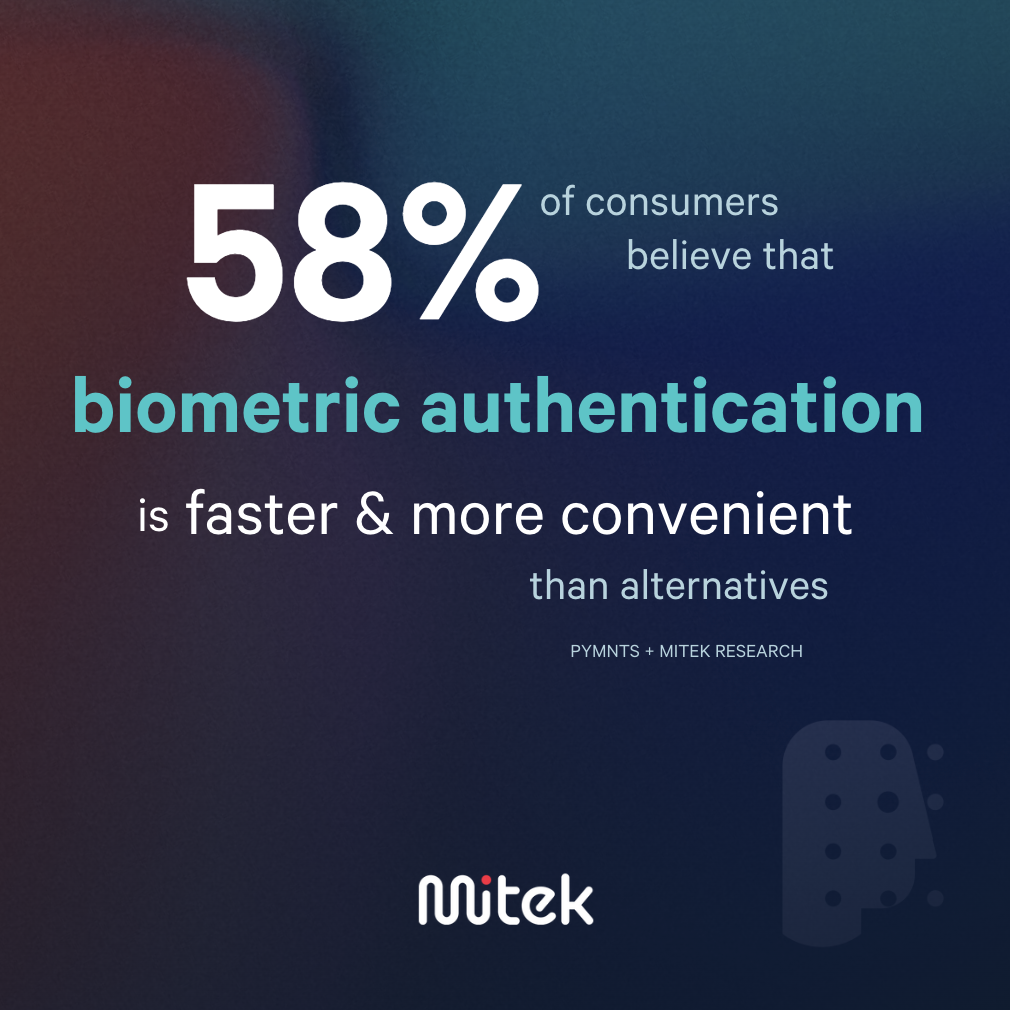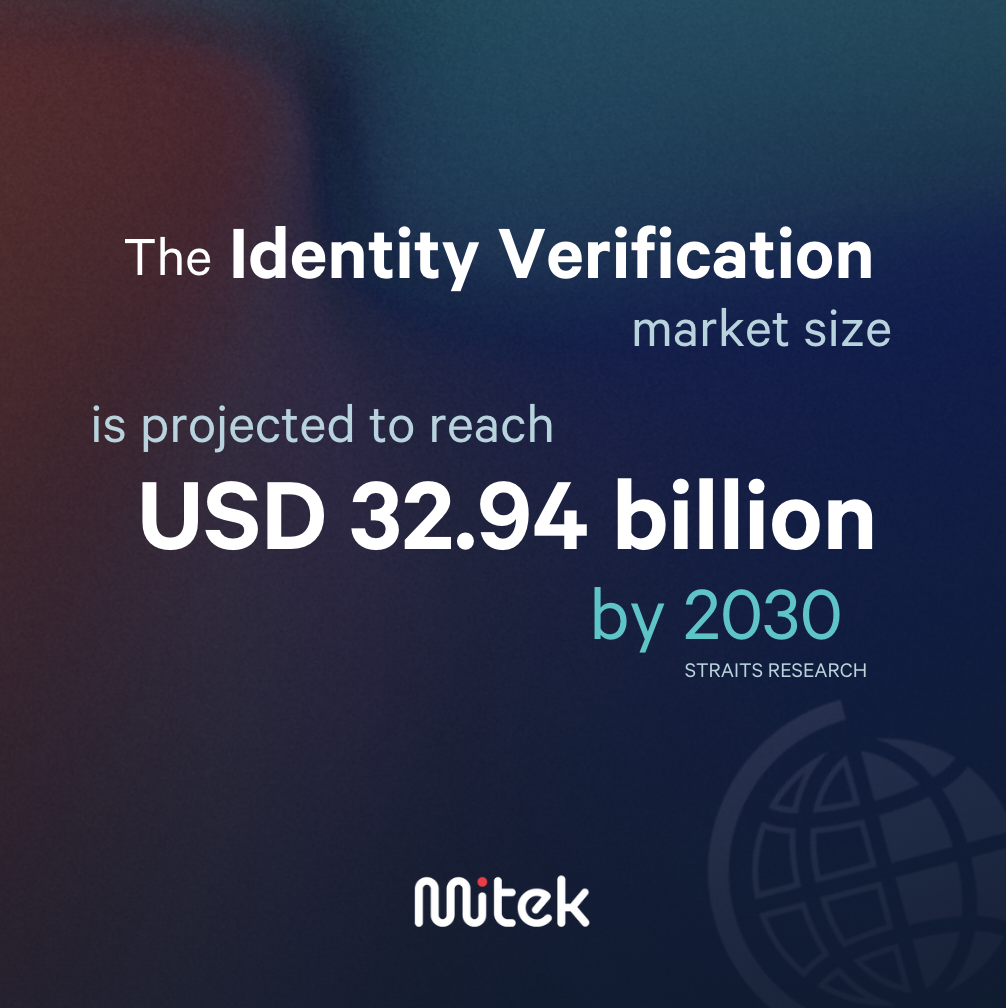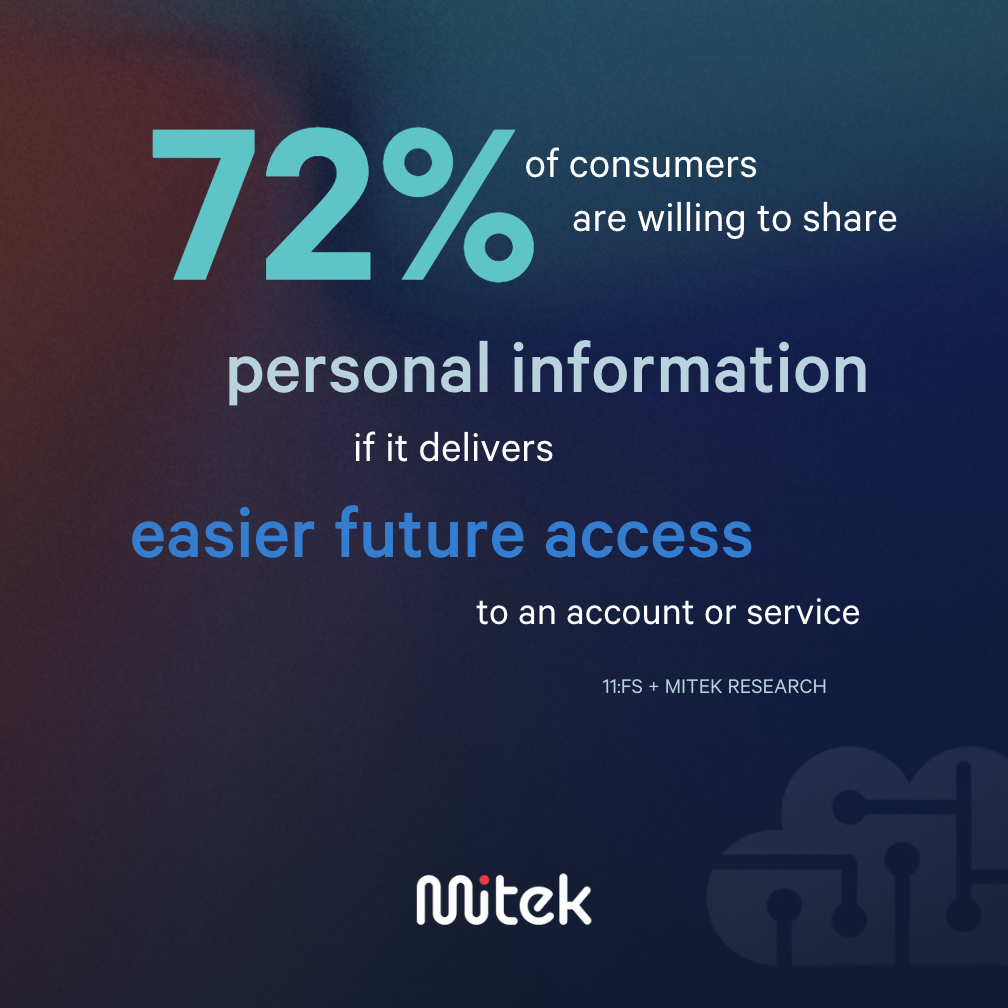
79 important IDV stats for 2023
A comprehensive list of helpful identity verification statistics
As our day-to-day lives become digitized, digital identities play an increasingly crucial role in interactions with businesses and one another. Digital identities remove friction from the customer experience. They make it easy to interact and communicate on various virtual platforms. As digital identities take hold, businesses must ensure that the owner of each identity is who they say they are to create safe environments and earn customer trust. As such, digital identity verification will be fundamental to business operations moving forward.
Below are 79 important identity verification statistics that you need to know as we move forward in the digital era in 2023.

1: Defining digital identity
One side effect of a digital economy is that consumers must manage dozens of relationships with service providers. Each new relationship requires managing login credentials and handing over personal information. Often, consumers err on the side of convenience rather than security when managing these relationships. As a result, this one-to-one relationship model isn’t sustainable. The need for a new identity-management model represents vast opportunity for vendors that understand the components of digital identity and how to broker trust between consumers and vendors while maintaining convenience.
There are 5 major conditions under which digital identities operate, which will endure regardless of the direction the industry takes:
- Privacy – How a user takes control of their digital identity
- Commerce – How a user leverages services to initiate transactions
- Reputation – How a user manages the information that makes up their online presence
- Data Protection – How a user protects their data and digital identity
- Inclusion – How a user gains access to services regardless of their personal conditions

2: Identity-management solutions market
Vendors are developing identity solutions to help simplify digital identity management and protect customers from fraud.
1. According to the University of Portsmouth, it’s estimated that fraud losses totaled nearly $5.4 trillion globally in 2021
2. Consumers average 100 passwords for their various accounts
3. The average user is locked out of 10 accounts each month
4. The market for reusable digital identity is projected to be worth $266.5B by 2027
- Reusable identities securely store an individual’s verified information. This verified identity can then be used with new entities so that consumers do not have to validate their identity every time they sign up with a new vendor
5. The market for mobile wallets is projected to be worth $16.2 trillion by 2031
6. The broader digital identity solutions market should be worth $70.7 billion by 2027
Often driven by being victims of fraud, consumers are trying to change their password behavior. Ponemon Institute research highlights this shift in action:
7. 61% now use stronger passwords [after suffering an account takeover or hacking]
8. 52% now change their passwords more frequently
9. However, just 35% use two-factor or multi-factor authentication

3: Digital identity verification
Advancements in digital identity technology have also opened the door for threats like deepfakes and synthetic identities. To combat these challenges, enterprising vendors have developed biometrics and other tools for layered identity-verification approaches.
According to an Experian survey:
10. 74% of consumers perceived physical biometrics to be the most secure method for digital identity verification
11. 72% of consumers said PINs sent to mobile devices
Continuity Central research highlights opportunity for authentication factors other than passwords and PINs:
12. Human error is the leading cause of serious insider data breaches, with 84% of organizations experiencing a security incident caused by a mistake
13. Organizations are concerned about what remote and hybrid work mean for future breaches
14. 54% believe that remote/hybrid working will make it more difficult to prevent data breaches caused by human error
15. 50% believe that hybrid and remote work will make it more difficult to prevent phishing attacks
16. 49% believe that it will be more difficult to prevent employees from breaking security rules if they’re working remotely in the future
Nordpass research finds that far too many people use guessable passwords. Millions of people use some of the most popular passwords, including “12345” and variations
17. It takes less than 1 second to crack most of the passwords on the list of most popular passwords
Identity verification is crucial for AML/KYC purposes.
18. Organizations spent nearly $1.4 billion in 2021 on AML and KYC data and services
19. 92% of Americans have placed an online order for goods or services
20. More than 75% of people have conducted at least some of their banking transactions online, necessitating more stringent identity-verification methods for financial institutions
21. 62% of highly connected consumers report having received payments via mobile wallets at least once over the past 12 months, at the time of the survey
Fines for AML breaches can cost institutions hundreds of millions of dollars.
According to Deloitte:
22. 62% of organizations say the biggest AML compliance challenges faced by banks is “increased regulatory expectations and enforcement of current regulations”
23. 55% say the biggest challenge is “Having sufficient numbers of adequately trained AML staff”
24. 48% say, “Insufficient/outdated technology to manage AML compliance obligations”
When asked what the biggest operational challenges that organizations face while complying with AML regulations...
25. 80% say “Manual (time consuming) processes”
26. 74% say “Poor quality of available data/lack of data/one view processes of customer”
27. 50% say, “Screening technology/ process produces too many false-positives”
Biometrics is the leading option for identity verification methods.
28. Two-thirds of people Visa surveyed have used biometrics. They cite the following reasons for wanting to use biometrics:
29. 42% don’t want to remember passwords
30. More than one-third (34%) believe biometrics offer improved security over passwords
31. One-third (33%) don’t want to forget or lose an authentication method
Among passwordless verification options, biometrics is a burgeoning option. Mitek and PYMNTS research found that:
32. 58% of consumers believe that biometric authentication methods are faster and more convenient than alternatives

33. 55% of consumers trust them more than methods, such as PINs and passwords
Research from Mitek and Javelin found that acceptance of biometrics is growing:
34. Consumers’ perceived effectiveness of facial recognition increased to 63%...
35. While retinal scanning remained steady at 62%
36. Voice recognition for the first time finally reached a 50% perceived effectiveness rate
According to Statista:
37. The broader biometrics market is projected to drive nearly $100 billion in revenue by 2027
38. 80% of active phones in the North America, Western Europe, and the Asia Pacific markets have enabled biometrics
The voice and facial recognition markets are poised to lead the way for biometrics technologies
39. The global facial recognition market is forecast to reach $8.5 billion by 2025
40. The voice recognition market is projected to reach a size of more than $27 billion by 2026
41. 53% of professionals agree that “biometrics will be a key enabler for anchoring digital identity”
Many global software developers engage with biometrics-related technologies.
42. 62% work with computer vision
43. 50% are working with conversational platforms/voice search
44. 37% are working on hearables
Businesses are leveraging biometric identity authentication.
45. American Airlines plans to expand its biometric-driven boarding program to 75 international gates by the end of 2022

4: Identity verification and customer experience
For modern identity verification to work, consumers must be comfortable providing some personal information to vendors. However, consumers are wary of repeatedly handing over their information while organizing all their different login credentials. Organizations that wish to use cutting-edge identity-verification technology must implement verification practices that do not add friction to the customer experience.
Straights Research projects:
51. The Identity Verification Market Size is projected to reach USD 32.94 billion by 2030

According to an Experian survey:
46. 55% of consumers say security is the most important aspect of their online experience.
47. However, consumers also said they’d abandon a transaction if they had to wait more than 30 seconds
According to Liminal research:
48. 42% of US consumers have given up on an online or mobile account opening process because of problems completing the application
A survey from Ponemon finds that on a scale of 1-10:
49. 64% of individuals rate “Not being inconvenienced when logging into online accounts” as 7 or higher
50. 60% rate “Being able to access online information as easy as possible” as 7 or higher
Mitek and PYMNTS research found:
51. 51% of mobile app users report that ease of use was the most important reason why they prefer fingerprint scans
52. 49% of both app users and browser users say ease of use was the most important reason why they select face scan authentication
53. 32% of digital account users accessing accounts from browsers say username and password combinations are their most preferred authentication method

5: Identity verification ethics
The U.S. Office of Science and Technology Policy has developed a framework for an AI Bill of Rights. This framework identifies “five principles that should guide the design, use, and deployment of automated systems to protect the American public in the age of artificial intelligence … from [threats] — and uses technologies in ways that reinforce our highest values.” A similar guide has emerged out of the EU.
54. In 2021, at least 89 court rulings referenced Illinois’ Biometric Information Privacy Act (BIPA). That number is more than 4-fold growth over 2019 rulings
55. More than 110 cases had been filed during the first quarter of 2022
Facial recognition technology can have unintended biases. Harvard research reveals:
56. Three algorithms had 34% higher error rates for darker-skinned females compared to lighter-skinned females
57. Another algorithm exhibited a 31% error rate for gender classification
The NIST is developing a standard for identifying and managing bias in artificial intelligence. The organization cites research, including:
58. An algorithmically deployed ad campaign designed to engage women about STEM careers. Yet, 20% more men than women viewed the ad, and the discrepancy was highest among working-age individuals
Consumers are willing to ditch brands whose morals don’t align with their own.
59. 61% of all UK shoppers, and 86% UK Gen Z shoppers have abandoned a brand because of something they heard or experienced that they didn’t like

6: Identity verification practices and trust
People are comfortable walking into a bank branch, handing an employee their identifying information and trusting that that information will not be misused. For digital identities and identity-verification practices to take hold, businesses must earn consumer trust in the virtual realm. Business like banks must meld the two as acceptance of AI- and technology-based tools grows.
A Liminal whitepaper reports that:
60. Only 25% of consumers believe most companies handle their sensitive personal data responsibly
61. 76% of consumers believe that sharing personal information is a necessary evil in today’s world
62. 85% wish there were more companies that they could trust with their data
63. 77% report that the account opening process can make or break their future relationship with a brand
64. 80% are wiling to spend time and money to protect their own data
65. 48% have switched companies or providers based on their data policies or data sharing practices
One way businesses can ease consumers’ apprehension is by requesting just the minimum amount of data necessary (11:FS + Mitek - The Digital Trust Report).
66. 52% of US customers trust companies that request only relevant data
Consumers should receive a benefit if they’re asked to share additional information:
67. 72% of consumers are willing to share info if it delivers easier future access to the account or service

Above all, consumer data must be safe:
68. 63% of US consumers would be more willing to hand over personal information if they had evidence that sensitive information was protected
YouGov and Mitek research found that:
69. Only half (52%) of UK bank customers feel that technology like artificial intelligence (AI) and biometrics positively impacts their trust in banks
70. Only 5% would prefer all interactions with AI/automated systems when engaging banks
71. Only 35% of people comfortable using a mobile banking app say they have set up face biometrics to log in. That number is 50% for 18 to 34-year-olds and drops to 20% for those 55-years-old or older
72. 77% of UK bank customers said that the ability to speak to a human when needed would have a positive impact on their trust
73. Those aged 55 and older are more likely (65%) to cite the ability to go to a local, physical branch than younger individuals (55%)
Research from Mitek and PYMNTS found that:
74. 69% of baby boomers and seniors are willing to use two-factor authentication
75. 55% of consumers trust biometric methods more than passwords and PINs
76. 72% of digital account users say that seamless logins will increase their trust in a service provide
Research from Mitek and Javelin uncovered a gap that exists between the desire for convenient and secure authentication and the actual adoption of this technology. This gap highlights how, despite growing comfort with non-traditional identity-verification methods, there is still work to be done to gain the public’s trust. For example:
77. Only 23% of consumers describe themselves as early adopters of new technology
78. Nearly half (44%) of consumers say they experience a level of apprehension when trying new technology as soon as it becomes available
79. And 38% of customers close accounts at businesses where fraud takes place due to lack of trust in security and technology, or a poor resolution
Hopefully these stats helped illustrate and inform the importance of IDV in the pivotal year to come. As the identity verification space continues to evolve, mutate, and grow exponentially into 2023, it is imperative that businesses proactively incorporate both identity verification and authentication processes into their business models. Doing so will not only deliver secure interactions and a trusted virtual experience, but it will modernize and automate a critical step for all organizations moving into the digital future.

Conclusion

Conor Rector is a content and customer advocacy leader focused on helping people understand identity, fraud prevention, and the technology shaping how we protect what’s real. With a background spanning storytelling, brand strategy, and community building, Conor brings a thoughtful, human-centered approach to complex topics.
https://www.linkedin.com/in/conor-rector-2178188/ Senior Content Lead at Mitek